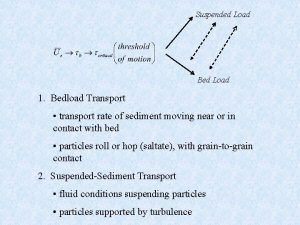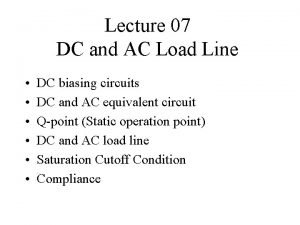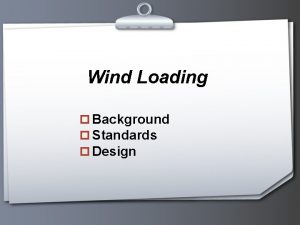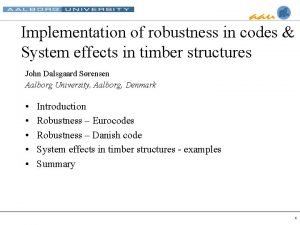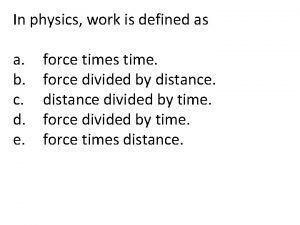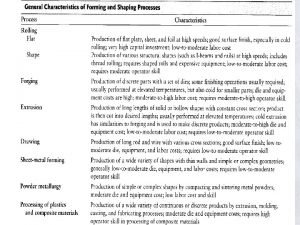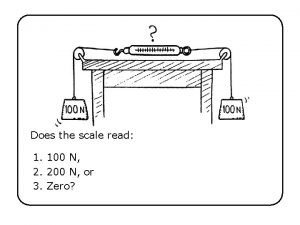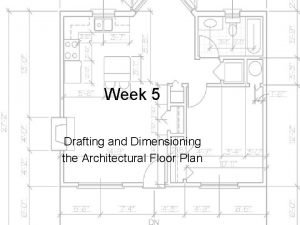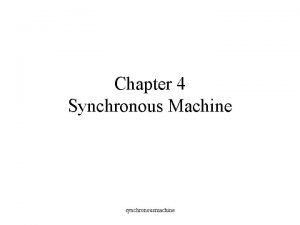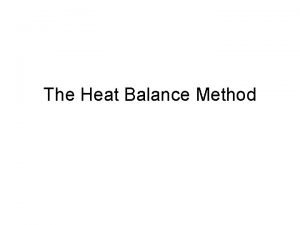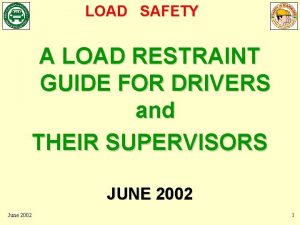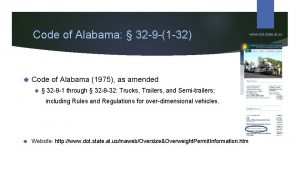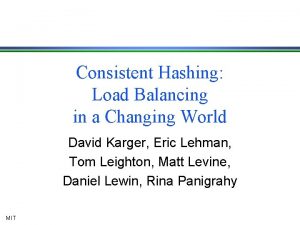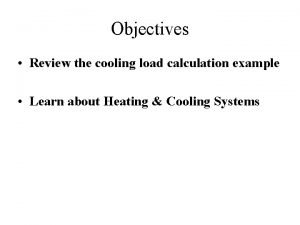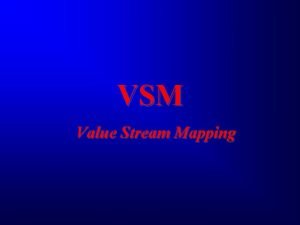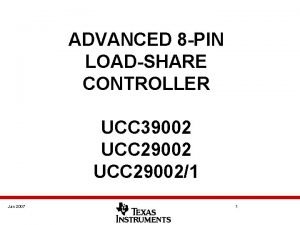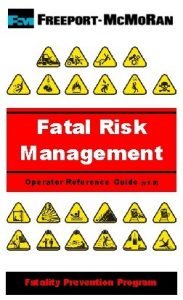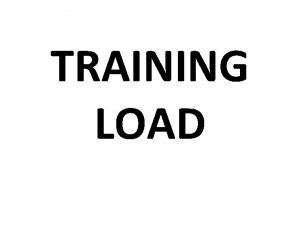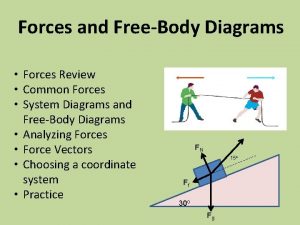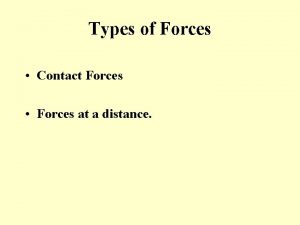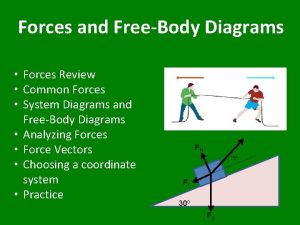WIND FORCES wind load Wind Load is an




























































- Slides: 60

WIND FORCES

wind load


Wind Load is an ‘Area Load’ (measured in PSF) which loads the surface area of a structure.


SEISMIC FORCES

seismic load



Seismic Load is generated by the inertia of the mass of the structure : VBASE = (Cs)(W) ( VBASE ) Redistributed (based on relative height and weight) to each level as a ‘Point Load’ at the center of mass of each Ffloor x = level: FX VBASE wx hx S(w h)

Where are we going with all of this?

global stability & load flow (Project 1) tension, compression, continuity equilibrium: forces act on rigid bodies, and they move nearly imperceptibly boundary conditions: fixed, pin, or roller idealize member supports & connections external forces: are applied to beams & columns as concentrated point loads & linear loads categories of external loading: DL, LL, W, E, S, H (fluid pressure) reactions: we use three equations of equilibrium to calculate these

internal forces: axial, shear, bending/flexure internal stresses: tension stress, compression stress shear stress, bending stress, stability, slenderness, and allowable compression stress member sizing for flexure member sizing for combined flexure and axial stress (Proj. 2)

EXTERNAL FORCES


200 lb ( + ) SM 1 = 0 0= -200 lb(10 ft) + RY 2(15 ft) = 2000 lb-ft RX 1 RY 1 10 ft 5 ft RY 2 = 133 lb ( +) SFY = 0 RY 1 + RY 2 - 200 lb = 0 RY 1 + 133 lb - 200 lb = 0 RY 1 = 67 lb 200 lb ( +) SFX = 0 RX 1 = 0 0 lb 67 lb 10 ft 5 ft 133 lb



w = 880 lb/ft RX 1 RY 1 24 ft RY 2

resultant force - equivalent total load that is a result of a distributed line load resultant force = area loading diagram resultant force = w( L) RX 1 RY 1 24 ft RY 2

resultant force - equivalent total load that is a result of a distributed line load resultant force = area loading diagram RX 1 RY 1 resultant force = w( L) 12 ft 24 ft RY 2 = 880 lb/ft(24 ft) = 21, 120 lb

resultant force - equivalent total load that is a result of a distributed line load resultant force = area loading diagram RX 1 RY 1 resultant force = w( L) 12 ft 24 ft RY 2 = 880 lb/ft(24 ft) = 21, 120 lb ( + ) SM 1 = 0

resultant force - equivalent total load that is a result of a distributed line load resultant force = area loading diagram RX 1 RY 1 resultant force = w( L) 12 ft 24 ft RY 2 = 880 lb/ft(24 ft) = 21, 120 lb ( + ) SM 1 = 0 – 21, 120 lb(12 ft) + RY 2(24 ft) = 0

resultant force - equivalent total load that is a result of a distributed line load resultant force = area loading diagram RX 1 RY 1 resultant force = w( L) 12 ft 24 ft RY 2 = 880 lb/ft(24 ft) = 21, 120 lb ( + ) SM 1 = 0 – 21, 120 lb(12 ft) + RY 2(24 ft) = 0 RY 2(24 ft) = 253, 440 lb-ft

resultant force - equivalent total load that is a result of a distributed line load resultant force = area loading diagram RX 1 RY 1 resultant force = w( L) 12 ft 24 ft RY 2 = 880 lb/ft(24 ft) = 21, 120 lb ( + ) SM 1 = 0 – 21, 120 lb(12 ft) + RY 2(24 ft) = 0 RY 2(24 ft) = 253, 440 lb-ft RY 2 = 10, 560 lb

resultant force - equivalent total load that is a result of a distributed line load resultant force = area loading diagram RX 1 RY 1 resultant force = w( L) 12 ft 24 ft RY 2 = 880 lb/ft(24 ft) = 21, 120 lb ( + ) SM 1 = 0 – 21, 120 lb(12 ft) + RY 2(24 ft) = 0 RY 2(24 ft) = 253, 440 lb-ft RY 2 = 10, 560 lb ( +) SFY = 0

resultant force - equivalent total load that is a result of a distributed line load resultant force = area loading diagram RX 1 RY 1 resultant force = w( L) 12 ft 24 ft RY 2 = 880 lb/ft(24 ft) = 21, 120 lb ( + ) SM 1 = 0 – 21, 120 lb(12 ft) + RY 2(24 ft) = 0 RY 2(24 ft) = 253, 440 lb-ft RY 2 = 10, 560 lb ( +) SFY = 0 RY 1 + RY 2 – 21, 120 lb = 0

resultant force - equivalent total load that is a result of a distributed line load resultant force = area loading diagram RX 1 RY 1 resultant force = w( L) 12 ft 24 ft RY 2 = 880 lb/ft(24 ft) = 21, 120 lb ( + ) SM 1 = 0 – 21, 120 lb(12 ft) + RY 2(24 ft) = 0 RY 2(24 ft) = 253, 440 lb-ft RY 2 = 10, 560 lb ( +) SFY = 0 RY 1 + RY 2 – 21, 120 lb = 0 RY 1 + 10, 560 lb – 21, 120 lb = 0

resultant force - equivalent total load that is a result of a distributed line load resultant force = area loading diagram RX 1 RY 1 resultant force = w( L) 12 ft 24 ft RY 2 = 880 lb/ft(24 ft) = 21, 120 lb ( + ) SM 1 = 0 – 21, 120 lb(12 ft) + RY 2(24 ft) = 0 RY 2(24 ft) = 253, 440 lb-ft RY 2 = 10, 560 lb ( +) SFY = 0 RY 1 + RY 2 – 21, 120 lb = 0 RY 1 + 10, 560 lb – 21, 120 lb = 0 RY 1 = 10, 560 lb

resultant force - equivalent total load that is a result of a distributed line load resultant force = area loading diagram RX 1 RY 1 resultant force = w( L) 12 ft 24 ft RY 2 = 880 lb/ft(24 ft) = 21, 120 lb ( + ) SM 1 = 0 – 21, 120 lb(12 ft) + RY 2(24 ft) = 0 RY 2(24 ft) = 253, 440 lb-ft RY 2 = 10, 560 lb ( +) SFY = 0 RY 1 + RY 2 – 21, 120 lb = 0 RY 1 + 10, 560 lb – 21, 120 lb = 0 RY 1 = 10, 560 lb ( +) SFX = 0 RX 1 = 0

resultant force - equivalent total load that is a result of a distributed line load resultant force = area loading diagram RX 1 RY 1 resultant force = w( L) 12 ft 24 ft RY 2 = 880 lb/ft(24 ft) = 21, 120 lb ( + ) SM 1 = 0 – 21, 120 lb(12 ft) + RY 2(24 ft) = 0 RY 2(24 ft) = 253, 440 lb-ft RY 2 = 10, 560 lb ( +) SFY = 0 RY 1 + RY 2 – 21, 120 lb = 0 w = 880 lb/ft RY 1 + 10, 560 lb – 21, 120 lb = 0 RY 1 = 10, 560 lb 24 ft 10, 560 lb ( +) SFX = 0 RX 1 = 0

SIGN CONVENTIONS (often confusing and frustrating) External – for solving reactions (Applied Loading & Support Reactions) + X pos. to right - X to left neg. + Y pos. up - Y down neg + Rotation pos. counter-clockwise - CW rot. neg. Internal – for P V M diagrams (Axial, Shear, and Moment inside members) Axial Tension (elongation) pos. | Axial Compression (shortening) neg. Shear Force (spin clockwise) pos. | Shear Force (spin CCW) neg. Bending Moment (smiling) pos. | Bending Moment (frowning) neg.

STRUCTURAL ANALYSIS: INTERNAL FORCES PVM

INTERNAL FORCES Axial (P) Shear (V) Moment (M)



RULES FOR CREATING P DIAGRAMS 1. concentrated axial load | reaction = jump in the axial diagram 2. value of distributed axial loading = slope of axial diagram 3. sum of distributed axial loading = change in axial diagram

-10 k 0 -10 k -20 k -10 k +20 k -20 k compression 0 +

RULES FOR CREATING V M DIAGRAMS (3/6) 1. a concentrated load | reaction = a jump in the shear diagram 2. the value of loading diagram = the slope of shear diagram 3. the area of loading diagram = the change in shear diagram

w = - 880 lb/ft 0 lb 10, 560 lb 0 0 0 +10. 56 k +10. 56 k V 10, 560 lb Area of Loading Diagram -880 plf = slope -0. 88 k/ft * 24 ft = -21. 12 k 0 +10. 56 k P 24 ft -10. 56 k + -21. 12 k = 10. 56 k

RULES FOR CREATING V M DIAGRAMS, Cont. (6/6) 4. a concentrated moment = a jump in the moment diagram 5. the value of shear diagram = the slope of moment diagram 6. the area of shear diagram = the change in moment diagram

w = - 880 lb/ft 0 lb 24 ft 10, 560 lb 0 0 +10. 56 k +10. 56 k slo s. po M 0 -0. 88 k/ft * 24 ft = -21. 12 k 63. 36 k’ +10. 56 k 0 zero slope 10. 56 k + -21. 12 k = 10. 56 k -10. 56 k ne g. slo pe -63. 36 k-ft 0 pe V Area of Loading Diagram -880 plf = slope +63. 36 k-ft P 10, 560 lb 0 Slope initial = +10. 56 k Area of Shear Diagram (10. 56 k )(12 ft ) 0. 5 = 63. 36 k-ft (-10. 56 k)(12 ft)(0. 5) = -63. 36 k-


Wind Loading W 2 = 30 PSF W 1 = 20 PSF

Wind Load spans to each level 1/2 LOAD W 2 = 30 PSF SPAN 10 ft 1/2 + 1/2 LOAD SPAN W 1 = 20 PSF 1/2 LOAD 10 ft

Total Wind Load to roof level wroof= (30 PSF)(5 FT) = 150 PLF

Total Wind Load to second floor level wsecond= (30 PSF)(5 FT) + (20 PSF)(5 FT) = 250 PLF

wroof= 150 PLF wsecond= 250 PLF

seismic load



Seismic Load is generated by the inertia of the mass of the structure : VBASE = (Cs)(W) ( VBASE ) Redistributed (based on relative height and weight) to each level as a ‘Point Load’ at the center of mass of the structure or element in : FX Fquestion = x VBASE wx hx S(w h)

Total Seismic Loading : VBASE = 0. 3 W W = Wroof + Wsecond

wroof

wsecond flr

W = wroof + wsecond flr

VBASE

Redistribute Total Seismic Load to each level based on relative height and weight Froof Fsecond flr VBASE (wx) Fx = (hx) S (w h)

Load Flow to Lateral Resisting System : Distribution based on Relative Rigidity Assume Relative Rigidity : Single Bay MF : 2 - Bay MF : Rel Rigidity = 1 Rel Rigidity = 2 3 - Bay MF : Rel Rigidity = 3

Distribution based on Relative Rigidity : SR = 1+1+1+1 = 4 Px = ( Rx / SR ) (Ptotal) PMF 1 = 1/4 Ptotal
 Bearing
Bearing Tributary load and load path
Tributary load and load path Pux
Pux Define dc and ac load line
Define dc and ac load line Intermolecular vs intramolecular
Intermolecular vs intramolecular Constructive forces and destructive forces
Constructive forces and destructive forces Like and unlike parallel forces ppt
Like and unlike parallel forces ppt Intramolecular forces vs intermolecular forces
Intramolecular forces vs intermolecular forces The forces shown above are
The forces shown above are Force and motion
Force and motion Intermolecular vs intramolecular forces
Intermolecular vs intramolecular forces Balanced forces and unbalanced forces venn diagram
Balanced forces and unbalanced forces venn diagram Wind load testing
Wind load testing Loading p
Loading p Self weight of roof truss
Self weight of roof truss Raumschotkurs
Raumschotkurs Facts about hydrosphere
Facts about hydrosphere Icao
Icao Smart load balancer
Smart load balancer Latent loads in radiant cooling
Latent loads in radiant cooling Load balancer redis
Load balancer redis Most streams carry the largest part of their load
Most streams carry the largest part of their load Stall speed load factor
Stall speed load factor Single phase full converter with r load
Single phase full converter with r load Load transfer
Load transfer Cascade layer picker
Cascade layer picker Load bearing vest pros and cons
Load bearing vest pros and cons Load bearing truss
Load bearing truss Take out your notebook
Take out your notebook 4 bit binary counter with parallel load
4 bit binary counter with parallel load Load and go assembler
Load and go assembler Load and go assembler
Load and go assembler Load duration curve excel
Load duration curve excel Hp stormrunner
Hp stormrunner Linear variable differential transformer
Linear variable differential transformer If you lift one load up two stories how much work
If you lift one load up two stories how much work Difference between flat rolling and shape rolling
Difference between flat rolling and shape rolling Uncompactable
Uncompactable Intrinsic load
Intrinsic load What is assembly language in computer
What is assembly language in computer Memctrl load
Memctrl load Arnold strongman and suzie small each pull
Arnold strongman and suzie small each pull Load distance method example
Load distance method example Dimensioning architectural drawings
Dimensioning architectural drawings Phasor diagram of synchronous motor
Phasor diagram of synchronous motor Heat transfer function
Heat transfer function Load restraint guide
Load restraint guide Cast diagram trig
Cast diagram trig Alabama overweight permits
Alabama overweight permits Consistent hashing load balancing
Consistent hashing load balancing Ektron discovery phase
Ektron discovery phase Gated wye friction loss
Gated wye friction loss Heating and cooling load calculation example
Heating and cooling load calculation example Critical load
Critical load Load arm
Load arm Asphalt pavement design example
Asphalt pavement design example Value stream mapping esempi
Value stream mapping esempi Load share controller
Load share controller Counters and shift registers
Counters and shift registers Fatality risk management
Fatality risk management Load flow analysis
Load flow analysis


